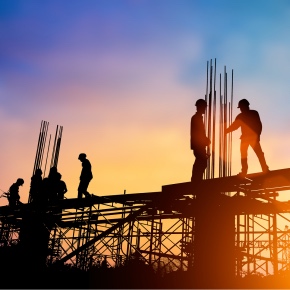
Addressing the risks of working at height
With numerous jobs in the UK construction industry requiring employees to work at height at one point or another, it’s no surprise that the industry has the reputation of holding the most dangerous jobs.
According to the HSE, falls from height are responsible for 20% of non-fatal accidents on construction sites, and in 2013-2014, 29% of fatal accidents.
With the introduction of The Work at Height Regulations 2005, further guidelines and requirements were brought in to prevent the number of injuries and deaths caused by falling from height. Any employer or person responsible for work at height within an organisation is responsible for enforcing these regulations, which, since their introduction, have resulted in an overall decline in the number of deaths in the industry.
Risks
While of course, the greatest risk of working at height is falling, there are other factors and indeed other risks associated with it. Harsh weather conditions such as rain, snow, lightening or wind speeds can affect the safety of workers performing tasks from height.
In addition, the proper setup and securing of access equipment, scaffolding or ladders is imperative. If a structure used for working at height is not properly secured or set up, the risk of falls and injuries increases exponentially.
Working at height can also pose a danger to individuals working on the ground. In many instances, tools and equipment used on access platforms, scaffolding, roofs and ladders can fall if not properly stored or secured. The items can land on employees below, resulting in head and other injuries.
Safety Tips
Proper Equipment and Maintenance:
Employees working from height rely on the structural integrity of ladders, scaffolding and access equipment for their safety. It’s important to ensure that these items are regularly inspected and maintained properly to ensure they are fit for purpose and that they are the right piece of equipment for a particular task. Railings, barriers and any safety equipment, such as harnesses, must also be inspected to ensure they are in suitable condition for the job.
Take Weather into Consideration:
While The Work at Height Regulations 2005 require that work is postponed during times of dangerous weather, it’s also important to ensure that the workplace is safe after the weather has occurred. Wet and slippery surfaces due to rain water or ice can pose a threat, as well as equipment that has been altered or damaged as a result of high wind speeds.
Worker Responsibility:
While it is the employer’s responsibility to comply with all regulations and safety precautions, they are also required to ensure that all employees are competent and able to safely undertake all tasks.
Employees also need to familiarise themselves with safe practices and requirements, and it’s vital that they undertake the relevant training courses.
Work from the Ground Where Possible:
The overwhelming consensus is that where possible, work should always be undertaken on the ground so that working at height can be avoided. Though it’s not always possible to do this, specific equipment or altering the way a task is approached can render working from height unnecessary, which will mitigate the risks.
Michael Grainger writes on behalf of UTS Sales and Repairs.
Latest news

26th July 2024
Enfield Speciality Doors completes world-class project for Atlas Copco HQ
A rundown office and warehouse building completely transformed into a modern headquarters for Atlas Copco has been fitted with more than 120 internal fire doors from Enfield Speciality Doors.
Posted in Access Control & Door Entry Systems, Articles, Building Industry News, Building Products & Structures, Building Systems, Case Studies, Doors, Interior Design & Construction, Interiors, Posts, Restoration & Refurbishment, Retrofit & Renovation, Security and Fire Protection, Sustainability & Energy Efficiency, Timber Buildings and Timber Products, Wooden products
26th July 2024
Abloy UK launches new white paper
Abloy UK, a leading provider of security and access control solutions, has launched a new white paper.
Posted in Access Control & Door Entry Systems, Architectural Ironmongery, Articles, Building Industry News, Building Products & Structures, Building Services, Doors, Facility Management & Building Services, Health & Safety, Information Technology, Innovations & New Products, Publications, Research & Materials Testing, Security and Fire Protection
26th July 2024
MCRMA Member Profile: David Roy, Director of Roofconsult
David Roy of MCRMA member company Roofconsult has more than 50 years’ experience to draw upon working in the building envelope sector and a unique perspective on how it has changed in that time.
Posted in Articles, BIM, Infrastructure & CAD Software, Building Associations & Institutes, Building Industry News, Building Products & Structures, Building Services, Building Systems, Cladding, Information Technology, Restoration & Refurbishment, Retrofit & Renovation, Roofs, Walls
26th July 2024
Strand: Enhancing Door Functionality and Safety
Craig Fox, Sales Director for Strand Hardware, outlines how door industry professionals might apply door limiting stays…
Posted in Architectural Ironmongery, Articles, Building Industry News, Building Products & Structures, Building Services, Doors, Facility Management & Building Services, Health & Safety, Restoration & Refurbishment, Retrofit & Renovation
 Sign up:
Sign up: